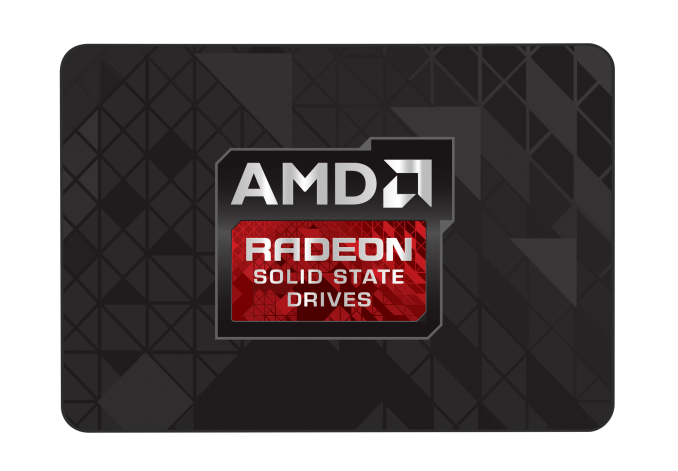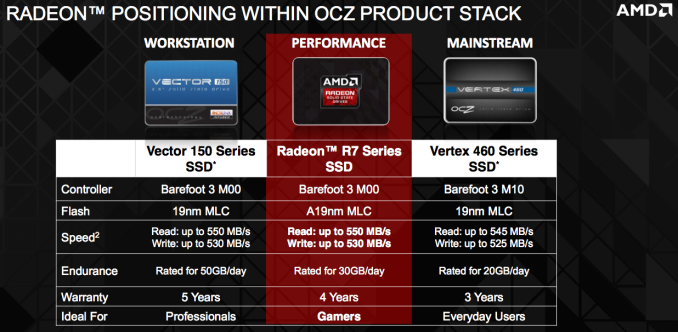AMD Jumps Into the SSD Market: Radeon R7 Series SSD Launched
by Kristian Vättö on August 19, 2014 12:01 AM EST
Back in 2011, AMD made a rather unexpected move and expanded its Radeon brand to include memory in addition to graphics cards. With today's announcement AMD is adding another member to its Radeon family by releasing Radeon R7 Series SSDs. Similar to AMD memory, AMD is not actually designing or manufacturing the SSDs as the product design and manufacturing is handled by OCZ. In fact, all the customer support is also handled by OCZ, so aside from the AMD logo AMD is not really involved in the product.
Partnering with OCZ makes sense because OCZ's focus with the Barefoot 3 platform has always been gamers and enthusiasts and that is the target group for AMD's R7 SSDs as well. OCZ is a now owned by Toshiba, so OCZ has direct access to NAND with guaranteed supply, whereas fabless OEMs (e.g. Kingston) could face supply issues that might harm AMD. Here's the quick overview, which of course will be essentially the same as certain existing Barefoot 3 products.
| AMD Radeon R7 Series SSD Specifications | |||||
| Capacity | 120GB | 240GB | 480GB | ||
| Controller | OCZ Barefoot 3 M00 | ||||
| NAND | Toshiba A19nm MLC | ||||
| Sequential Read | 550MB/s | 550MB/s | 550MB/s | ||
| Sequential Write | 470MB/s | 530MB/s | 530MB/s | ||
| 4KB Random Read | 85K IOPS | 95K IOPS | 100K IOPS | ||
| 4KB Random Write | 90K IOPS | 90K IOPS | 90K IOPS | ||
| Steady-State 4KB Random Write | 12K IOPS | 20K IOPS | 23K IOPS | ||
| Idle Power | 0.6W | 0.6W | 0.6W | ||
| Max Power | 2.7W | 2.7W | 2.7W | ||
| Encryption | AES-256 | ||||
| Endurance | 30GB/day for 4 years | ||||
| Warranty | Four years | ||||
| MSRP | $100 | $164 | $299 | ||
The R7 is based on OCZ's own Barefoot 3 controller and it is the same higher clocked M00 version (397MHz) as in the Vector 150. The new ARC 100 and Vertex 460 use the M10 version, which runs at 352MHz instead of 397MHz but is otherwise the same silicon. Performance wise the R7 SSD is very close to Vector 150 with slightly lower random write performance, although random read performance is marginally better in turn.
The biggest difference between the two is endurance as the Vector 150 is rated at 50GB per day for five years (91TB total) while the R7 is rated at 30GB per day for four years (43TB total). The firmware in the R7 is tailored for AMD, although I was told that the customizations are mainly wear-leveling related to increase endurance over the Vertex 460, so there should not be any surprises in performance. The NAND is also different as the R7 utilizes Toshiba's A19nm MLC, but OCZ should be making the switch to A19nm across its whole client SSD lineup soon to cut costs.
The motivation behind AMD's move is identical to the reason AMD entered the memory market. AMD wants to provide users an "AMD-only" experience by offering as many of the components as possible. Another argument AMD had is that providing more AMD branded products makes it easier for novice PC builders to pick the parts because the buyer does not have to go through the trouble of deciding between dozens of products and making sure the parts are compatible with each other. In addition to providing an easier purchase experience, AMD can also use the R7 SSDs in bundles and promotions, which is definitely more lucrative than using third party components.
Of course, the ultimate reason behind the move is that SSDs are becoming a mainstream product, and they provide another revenue source for AMD. AMD has not been doing that great financially lately and having an extra low risk revenue source is definitely welcome, even though client SSDs are not exactly a high profit market anymore. Then again, AMD is not investing much into SSDs since development and manufacturing is done by OCZ, so even if Radeon R7 SSD sales end up being low, AMD has no long-term investment to protect. The announced pricing is generally in line with what we're seeing for the existing OCZ Vector 150 products, though mail-in rebates can actually drop the Vector 150 below Radeon R7 SSD levels.
All in all, the R7 will not provide much from a technological standpoint since it uses the same platform we have tested several times, but it will be interesting to see how AMD bundles the R7 with other AMD products. AMD now has an opportunity to provide even more extensive bundles (CPU/APU, GPU, RAM and SSD); all that's left is for AMD to begin offering Radeon branded motherboards, power supplies, and cases to provide the ultimate AMD-only experience. Whether that happens remains to be seen, but AMD is trying an aggressive bundling strategy to increase their desktop CPU sales.
We have samples of the Radeon R7 SSD on the way, so stay tuned for the full review!











43 Comments
View All Comments
willis936 - Tuesday, August 19, 2014 - link
Did you just find a time machine to travel 20 years into the future and post this?SleepyFE - Tuesday, August 19, 2014 - link
Products inside the PC work (at worst with a driver). But i have a D-Link router that has a USB slot intended for a USB modem with a SIM slot. If i find a D-Link USB it will work while anything else might work. The brand is to help novices. They have just started to look at the products inside the PC. Until now they dealt with things like my example. Finding same brand components is easy and as the article said, for novices.Da W - Tuesday, August 19, 2014 - link
Never heard of anobody picking DDR-1333 RAM or slow SSD that doesn't work? In case you didn't get it, AMD is picking which SSD and RAM you should take in the gazillion on brands and product numbers available.Tams80 - Tuesday, August 19, 2014 - link
And how does this negatively affect you?More to the point it's marketing, but not B.S. AMD are trying to build a brand that has components that work well together, so when people buy those components and they work well, they will be more likely to buy more into the brand. You may not like branding and may not buy into it, but many people do. They are a large resource to be tapped into.
Anyway; a 1TB version would be appreciated.
tipoo - Tuesday, August 19, 2014 - link
So this AMD SSD is just like their memory sticks, the controller is by another company, the NAND is by a different company, almost no engineering (but the sticker design I guess?) came from AMD. Meh.xype - Tuesday, August 19, 2014 - link
If it’s sticker _and_ certification/testing it might very well be worth the money to anyone building an AMD-based system. *shrug*dishayu - Tuesday, August 19, 2014 - link
I don't think compatibility is that big of an issue these days... Besides CPU and Motherboard, all PCs use (or can use) the most commonly available components... SATA is backwards compatible, DDR3 is the only type of memory you can practically buy, PCI-e is backwards compatible (both ways), power supplies are common. You actually have to go out of your way and put in effort, if you want to find products that are not compatible with each other. I don't see that as a legitimate argument at all.silverblue - Tuesday, August 19, 2014 - link
Perhaps not. Still, there is the price argument which is a little harder to ignore - buy a (nearly) full system with AMD components which could potentially cost a lot less than the Intel equivalent. If you opt for the SSD at the very least, you remove the most noticable performance barrier in computing, no matter how cheap and nasty it is.Dug - Tuesday, August 19, 2014 - link
I see bad components all the time. Just look at reviews on Newegg. You will see many issues that you wouldn't normally think about pop up in reviews. Usually because of either poor parts used, bad controller boards, bad design, bad drivers, etc.raghu78 - Tuesday, August 19, 2014 - link
AMD's strategy of bundling is laying the foundations for full gaming PC bundles in the near future. AMD's 2016 APUs with a new x86 architecture and HBM (High bandwidth memory) will bring APUs with performance which will satisfy the vast majority of casual and mainstream gamers. The enthusiasts would still want discrete GPUs and custom PC builds. Eventually AMD needs to have their own branded motherboards and power supplies to provide complete bundles to OEMs and system integrators.